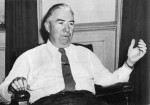In my Don Bolles homicide-related Newsletter No. 50, entitled “A Case of Curious Coincidences”, first published in my February 26, 2009 newsletter and now this blog, I also provided brief commentary on the much earlier murder in Illinois of the first wife of Motorola founder Paul Galvin. Along with her young maid, Edna Sibilski, the middle-aged Lillian Galvin was shot to death in 1942 in her upscale Evanston home in what was made to look like a burglary-gone-bad. However, it actually could have been a non-divorce, hired-gun alternative to an increasingly dysfunctional marriage.
After release of that newsletter, I later discovered that author Ovid DeMaris in his 1969 book Captive City, the classic volume on the once-excessive Mafia presence in Chicago, described Illinois State’s Attorney Thomas Courtney and his chief investigator Captain Dan Gilbert as having been two of the most corrupt law enforcement officials in state history back in their day. These, of course, were the very same two men, both acknowledged personal friends of Paul Galvin, who conducted their myopic inquiry into the double homicide of Galvin’s wife and her maid, which inquiry predictably went nowhere.
In my 2009 newsletter (this blog), I also noted that Paul “Needle Nose” Labriola, a Windy City mob figure of the 1940s and 1950s, had been quoted in the Chicago Tribune saying, “They never should have planned the Galvin killing when the maid was in the home,” obviously suggesting Mafia knowledge of the crime. According to author DeMaris, the pointy-beaked and loose-lipped Labriola later was found garroted and stuffed in the trunk of a car.
 In 1965, Harry Mark Petrakis produced an authorized and conspicuously friendly biography of Paul Galvin, called The Founder’s Touch. In discussing Galvin’s determined opposition to any recognition of trade unions at Motorola, Petrakis illustrated Galvin’s claim of non-union worker satisfaction and loyalty by pointing to an instance in which union organizers began passing out handbills outside a Chicago-area plant. As the author told it, the organizers “were promptly driven off with blows by a group of factory people.” Really? Having met a number of long-standing Motorola employees, I frankly find that quite hard to picture. Soon after Newsletter No. 50 was issued in 2009, I had occasion to interview journalist-historian Burton Hersh in Florida, author Gus Russo in Maryland, and retired Chicago police official John Flood in Nevada. All three are recognized experts on Chicago Mafia activities during the period in question, and I learned the following:
In 1965, Harry Mark Petrakis produced an authorized and conspicuously friendly biography of Paul Galvin, called The Founder’s Touch. In discussing Galvin’s determined opposition to any recognition of trade unions at Motorola, Petrakis illustrated Galvin’s claim of non-union worker satisfaction and loyalty by pointing to an instance in which union organizers began passing out handbills outside a Chicago-area plant. As the author told it, the organizers “were promptly driven off with blows by a group of factory people.” Really? Having met a number of long-standing Motorola employees, I frankly find that quite hard to picture. Soon after Newsletter No. 50 was issued in 2009, I had occasion to interview journalist-historian Burton Hersh in Florida, author Gus Russo in Maryland, and retired Chicago police official John Flood in Nevada. All three are recognized experts on Chicago Mafia activities during the period in question, and I learned the following:
- from Hersh that many Chicago-area companies routinely used the Mafia for union-busting, that mob guys “hired themselves out” to break up union rallies and demonstrations;
- according to Russo, Chicago-area corporations routinely used “mob friends” to bust union efforts or to set-up sweetheart unions;
- and from Flood, otherwise respectable Chicago-area corporations routinely would “rent low-level mob goons” to shut down union organizing drives.
That certainly sounds to have been a more likely scenario for Motorola in the Chicago area as well. In other words, even before the strange death there of his first wife, Paul Galvin already could have known a few phone numbers to call when that kind of help was needed. And that could have been how the ensuing saga really began.
Again, in the 2009 Newsletter No. 50 (here), I also reported having been told by a retired Motorola security official in Arizona that the organized crime theft of gold from company electronic plants in Phoenix, especially from the facility at 52nd Street and McDowell, had been “a huge problem.” How big was “huge”? In the newsletter’s aftermath, a couple of former in-house Motorola accountants in Phoenix sent word to me that—over the 1968-82 span of such Mafia diversion of Motorola gold—there could have been at times “as much as a million dollars a month at risk.” They knew how much gold Motorola was buying, but they lacked effective controls, they complained, over how much gold the company was actually using. Bear in mind that, because local journalist Don Bolles was killed in 1976 before he could expose it, the mob scam went on for six more years.
Early this year, after copies of Newsletter No. 50 had been circulated without my foreknowledge by a former Motorola employee in Arizona to some of his other retired colleagues here, a number of them invited me to lunch in a private dining room at a well-known Valley steakhouse so that we could talk about the various Motorola-related issues in more detail. Following considerable discussion, almost all of them seemed quite receptive to what I had described in the piece. Only a few appeared to be a bit dismayed by, even resistant to, its central allegations.
In addition to collective confirmation of Motorola’s anti-union bias stemming from Paul Galvin’s reign, one of this group who had held a mid-management position at a Phoenix-area
plant described once having hired a Black applicant for a particular job opening as the candidate best qualified. He later was warned by someone above him in the company’s hierarchy that the decision might cost him his own job. It was explained to him that then Motorola CEO Bob Galvin, who held that top corporate post for almost three decades from his father’s death in 1959 until 1986, was actively intent on minimizing the hiring of black employees. As CEO he reportedly justified his informal policy of racial discrimination by claiming that the shooter who had killed his mother years ago in 1942 was suspected of being a Black fellow. Bob Galvin himself recently died in his own retirement back in Illinois in 2011.
Several years ago, members of the extended family of Edna Sibilski, the maid also murdered with Lillian Galvin, re-opened lines of communication with the Evanston Police Department in Illinois, seeking an update on that very old “cold case.” Through Evanston PD, they subsequently got in touch with me as well, still trying after all these years to make sense of what truly might have happened. Conversely, Evanston PD has not reported any such followup contacts over the many years from surviving members of the Galvin clan, perhaps not so interested in sorting out the violent tragedy that occurred there.
Copyright © 2013 Don Devereux, All Rights Reserved
Journalists, historians, teachers, and students are free to quote from any of this material in writings of their own, provided that they do so with proper attribution and acknowledgement of applicable copyrights.


…thanks for the update. Best Regards: DW
________________________________
It’s always good to hear from you, and I hope all is well with you and yours in SD. Best wishes.
Anita:
I do recall you, of course, including our prior contacts by phone and email back in 2009. While I certainly sympathize with your frustration, there actually is not much of anything that Evanston PD can do at this point about the officially unsolved murders of Lillian Galvin and her maid Edna Sibilski in October 1942.
That double homicide now will have occurred 71 years ago, rendering any renewed investigation virtually impossible. And Evanston PD’s own police reports in the case even mysteriously seem to have vanished some years ago, leaving local police there—as with you and me—heavily dependent on relevant press clippings of the period.
I can assure you, however, that there indeed are current members of Evanston PD well aware that the prevailing law enforcement responses of the 1940s was badly mishandled, controlled not by their department but by a couple of notoriously corrupt officials with the Illinois State Attorney’s Office who not so coincidently were also old pals of Paul Galvin.
I trust that contemporary readers can now draw their own more accurate conclusions about what really must have happened.
Even so belatedly, let me say to you and your family that I’m sorry for your loss.
Don….I would like to talk with you about the Galvin case…….
Dear Don;
You sir are a real saint and hero trying to find justice for the families of these two ladies murdered in 1942. I inadvertently came across this story while linked to another article on the McCain/Hensley/Marley alcohol distribution businesses in AZ. I have never lived in AZ and never heard of this case, but I had heard of rumors regarding the Kemper Marley connections to the mob and McCain’s father-in-laws related connections as Marley’s “fall guy” in a felony.
I despise McCain and his fellow RINO’s who are complicit with the demonrat party for wrecking the USA as a Constitutional Republic.
It is dismaying to read about the possibility that Motorola’s Galvin may have conspired to murder his wife and use mafia goons to beat back union efforts, but unfortunately, greed is one of the Seven Deadly Sins. I have cousins in Chicago and have visited the city my entire life, and I am not surprised at any story of corruption and cover-up which emanates from “cesspool on Lake Michigan”.
Please continue your magnificent fight to uncover political and economic corruption and bring the guilty to justice in these cases. We all must “fight the good fight” to save this nation.
Blessings to you,
CBC
Houston, TX
Mr Ceisel:
I appreciate your interest in the tragic 1942 murders of Lillian Galvin and her maid Edna Sibilski in Evanston, Illinois, about which I expressed my obvious suspicions. Sadly, after all these years, we’ll probably never know the absolute truth.
Apart from that, while I’m neither a Democrat nor a Republican, I don’t believe that resorting to nasty name-calling regarding the Democratic Party on one hand and U.S Senator John McCain on the other help to elevate this nation’s political discourse to a more civil level, so badly needed if present governmental dysfunction and gridlock are to be overcome.
Having said that, I will, of course, do my best to continue to “fight the good fight” as an investigative journalist.
Don Devereux
May 16, 2014